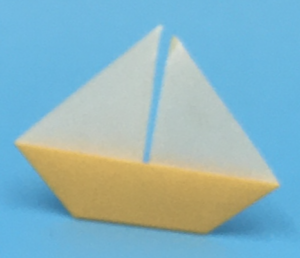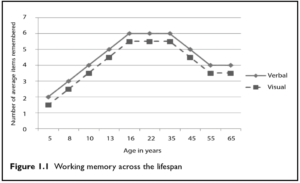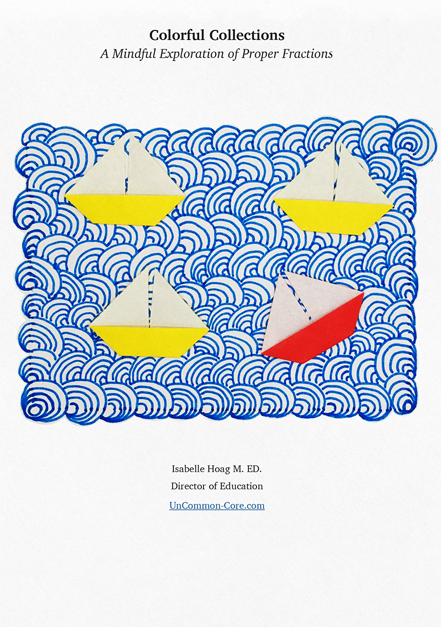
What is Cognitive Load?

The first time a child folds an origami boat, they must keep track of a lot of new information. They have to remember the steps (or remember where to find them), they have to remember what each origami instruction means, they need to keep track of the steps in sequential order and remember which step they are on. Then there are many details to think about such as: lining up the edges of the paper, putting their fingers in the right place to hold the paper still while making a neat crease, thinking about the final result and whether or not the color will be on the outside or inside of the model. Some of this information will slip out of working memory and never get processed (stored in long term memory) simply because there are so many bits of information.
With practice, the child recognizes what the symbols mean. They tap long term memory to recall the meaning of each symbol, saving working memory for new information. The sequence of steps becomes familiar which also frees up working memory. Their fingers develop muscle memory in terms of how to handle the paper. Reducing cognitive load opens up space in your students’ working memories.
Let’s focus on two types of cognitive load that impact how students learn. Intrinsic cognitive load is is determined by the level of difficulty and the number of new concepts or skills being presented at one time. Extraneous cognitive load includes distractions either from the classroom environment or distractions which are specific to an individual student. These include preoccupation with hunger, strong emotions, sleepiness, and so on. Teachers automatically know how to reduce obvious causes of extraneous cognitive load: no one would learn anything during a thunderstorm in a library. Still, the more we know about cognitive load and its impact on working memory, the better off our students will be.
Cognitive load is the amount of information competing for a students’ attention. Students can only hold so much in their working memory. When there is too much new information for students to keep in working memory, then some of it will get lost. Teachers who reduce cognitive load help students learn math.
What is Working Memory?
Working memory holds information while it is being processed. But how much information can be held at one time? How can teachers make sure that students’ working memories hold onto new information long enough for it to be combined with previous learning?

Alloway Page 4
More bits of information can be held in working memory as children get older. The amount of new information held in working memory varies from child to child and between different tasks. Reducing the amount of information that students need to hold in working memory in order to solve math facts makes those facts easier to remember.
Help Students Learn Math Facts by Reducing Cognitive Load
- Establish and teach routines that will be used throughout the year for learning math facts. Once your students know how to use flashcards or play games like Dragon’s Dozens, they won’t have to use working memory to perform these tasks.
- Give your students time to reflect on what they have just learned. Reflection helps them integrate new information with big ideas and concepts they have already learned. It gives them time to identify questions or puzzles and ask for clarification.
- Tell your students what you want them to focus on during each lesson. Be clear; share learning goals.
- Remember: Slow is Smooth & Smooth is Fast. (Apply what he says to education!) Make Haste Slowly.
- Make sure you have your students’ complete attention before giving any directions.
- Give one instruction at a time, or share written instructions. Be prepared to repeat multistep directions as needed.
- Create classroom routines that are used consistently. Give your students plenty of time and guidance while they learn the routines.
- Give them fewer math facts or number bonds to work with at one time. A tall pile of flashcards would intimidate anyone causing a distraction which adds to the cognitive load of the assignment. A few flashcards are much easier to focus on.
- Think of ways to make the tasks easier at first, slowly increasing the amount of information for your students to remember.
What Increases Students’ Working Memory Capacity?
Working memory capacity naturally increases with age – reaching its zenith when we are young adults. Still, there are several ways that teachers and caregivers can help young children improve their working memories.
- Playing card games requires children to remember the cards they have in their hands and perhaps remember which cards have already been played by their friends. They also have to keep the rules of the game in mind as they play.
- Games like Concentration, Apples and Doorknobs, and The Farmer’s Cat help, too.
- Engage your students in class or small group discussions. Listen to their ideas and explanations for – well – anything that interests them. Ask questions. Conversations like this require children to keep track of the questions you ask, what they have already said, what other students have said, and ideas they would like to add to the discussion. These kinds of conversations help children recall: known information, topic centered vocabulary, and interesting examples to support their ideas.
Resources:
- Cognitive-Load Theory: Methods to Manage Working Memory Load in the Learning of Complex Tasks – Fred Paas
- Improving Working Memory: Supporting Students’ Learning by Trac Pachiam Alloway
Share This Story, Choose Your Platform!
Download Colorful Collections:
A Mindful Exploration of Proper Fractions
Help your students make sense of fractions.
I started teaching in 1987, which means I’ve collected many tips and tricks along the way. In this ebook, I share concepts, strategies, and classroom materials to help you make math sticky.
Along with this useful ebook, you will receive weekly emails from StickyMath@UnCommon-Core.com. I send information like: teacher tips, educational ideas, book reviews, curated lists, reviews of educational sites, and free first drafts of products that I’m creating for my TPT store. That way, you get helpful ideas and free stuff, while I get some feedback before I finalize products and put them up for sale.
I value your privacy. I will never sell your information. You may unsubscribe at any time.
All the best!
Isabelle
Isabelle Hoag M. Ed.

